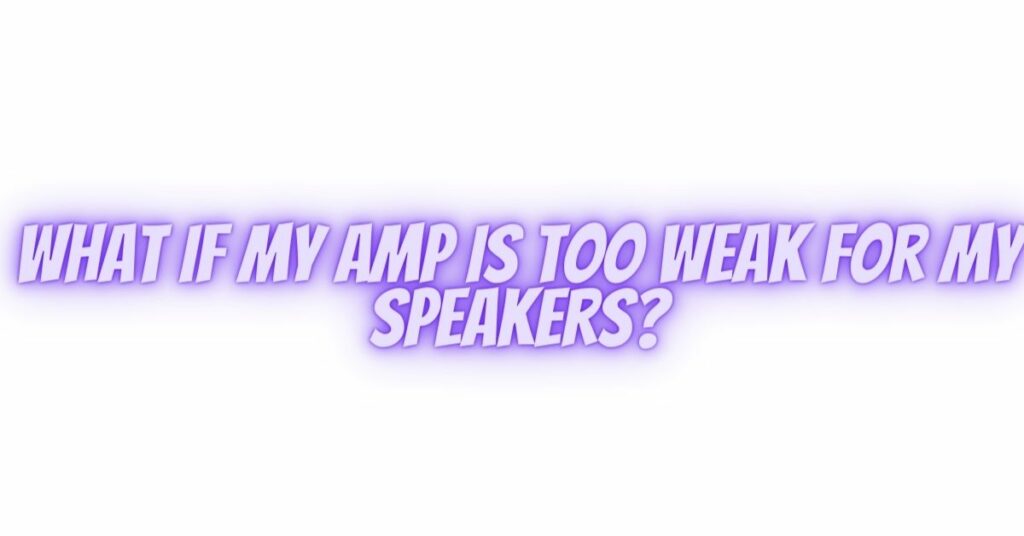In the world of audio equipment, matching your amplifier’s power to your speakers is crucial for achieving optimal sound quality and system performance. But what happens when you find that your amplifier is too weak for your speakers? In this comprehensive article, we will explore the consequences of such a mismatch and discuss potential solutions to address the issue.
- Understanding Amplifier and Speaker Mismatch
Amplifiers and speakers have specific power ratings that indicate their capabilities:
- Amplifier Power Rating (Watts): This rating signifies the maximum power output that the amplifier can deliver to the connected speakers without distortion or damage. It’s often expressed as the RMS (Root Mean Square) power rating.
- Speaker Power Handling (Watts): This rating represents the maximum amount of power that a speaker can handle without overheating or sustaining damage. It is also usually expressed as the RMS power handling.
When your amplifier is too weak for your speakers, it means that the amplifier’s power output does not meet the requirements of the speakers, which can result in various issues.
- Consequences of a Weak Amplifier
Using an amplifier with insufficient power for your speakers can lead to several problems, including:
- Inadequate Volume: The most noticeable issue is that the audio system will not produce enough volume to meet your desired listening levels. This can be frustrating when you want to play music loudly or fill a larger space with sound.
- Distortion and Clipping: An underpowered amplifier may struggle to deliver the necessary power, resulting in distortion and clipping when pushed to higher volumes. This not only affects audio quality but can also damage speakers.
- Reduced Sound Quality: Insufficient power can cause speakers to produce sound less accurately, leading to poor sound quality with muddied bass and unclear highs.
- Risk of Speaker Damage: Operating speakers with an underpowered amplifier may cause speakers to overcompensate and attempt to draw more power than the amplifier can safely provide. This can lead to overheating and potential damage to the speakers.
- Potential Solutions
If you find that your amplifier is too weak for your speakers, several potential solutions can help address the issue:
- Upgrade the Amplifier: The most effective solution is to upgrade to a more powerful amplifier that matches or exceeds the power handling of your speakers. A well-matched amplifier ensures clean, distortion-free sound and proper protection for your speakers.
- Bi-Amping or Tri-Amping: In some cases, you can use multiple amplifiers to power different frequency ranges of the speakers. This approach, known as bi-amping (two amplifiers) or tri-amping (three amplifiers), allows for more precise control and power distribution.
- Use External Processing: Employ external signal processors, such as equalizers or active crossovers, to help optimize the power distribution to your speakers. These devices can help ensure that each speaker receives the right amount of power.
- Reconsider Speaker Placement: Adjusting the placement of your speakers in your listening environment can help improve sound distribution and minimize the need for excessive power.
- Speaker Efficiency: Consider replacing your speakers with more efficient models (higher sensitivity ratings). Speakers with higher sensitivity can produce more sound with less power.
- Use a Subwoofer: If you’re experiencing bass-related power issues, consider adding a subwoofer to your system. A subwoofer can alleviate the demand on the main speakers and amplifier.
- Volume Management: When dealing with a weak amplifier, practice volume management. Avoid pushing the system to its limits, and keep the volume at reasonable levels to reduce the risk of distortion and damage.
Conclusion
When your amplifier is too weak for your speakers, it can lead to issues related to volume, sound quality, distortion, and potential speaker damage. The best solution is to upgrade to a more powerful amplifier that matches your speaker’s power handling capacity. This ensures clean and undistorted sound while protecting your speakers.
In the absence of an immediate amplifier upgrade, you can explore alternatives like bi-amping, external processing, speaker placement adjustments, or speaker replacements with higher sensitivity. While these solutions can help mitigate the issue to some extent, upgrading to a properly matched amplifier remains the most effective and comprehensive solution for achieving the best audio performance.


